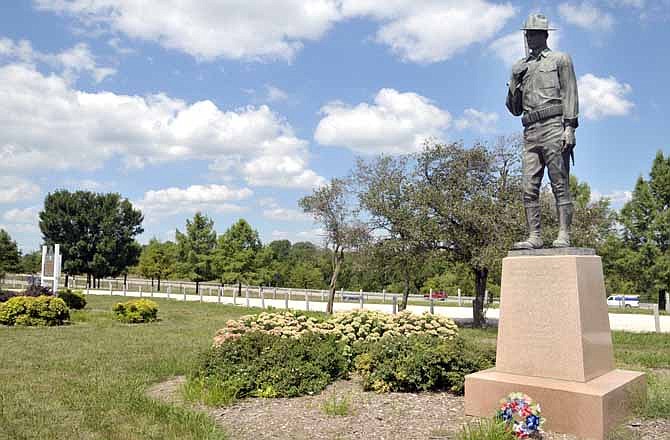A life-sized bronze of a militiaman represents a pivotal point in the evolution of the Missouri National Guard.
Dressed ready for military duty at the turn of the 20th century, the figure, created by St. Louis sculptor Carl Mose, also has set watch over the U.S. 50 Blue Star Memorial park on the west end.
As the Guard's Museum of Missouri Military History prepares to relocate to a more publicly accessible location on the Ike Skelton Training Site, historians considered the statue could have a more prominent display in front of their project.
The Spanish-American War memorial was installed at its current site in 1967, though it was not originally placed there in 1963, when it was dedicated, according to the Smithsonian Institute.
As Guard representatives have been visiting with various organizations that might be impacted by a relocation of the figure, such as the Sons of Spanish-American War Veterans Association and the Federated Garden Clubs, they have met with positive response.
However, the Missouri Department of Transportation (MoDOT), which owns the park land, recently received unsolicited letters from both Jefferson City and Cole County officials in opposition to the statue being placed at the Guard.
MoDOT has no plans to sell the property or close the park, said Sally Oxenhandler, customer relations manager. The oppositional comments have been passed on to the Guard.
Roadside parks were essential for the motoring public in the early and mid-20th century.
That made them a popular setting for memorials and markers.
The local park includes the Hawthorn Garden Club's Blue Star Memorial Highway sign, a program formed between MoDOT and the Federated Garden Clubs.
And the circle-drive area off of Missouri Boulevard features a large, aged metal sign detailing the city's history on one side and the seat of state government's on the other, erected by the State Historical Society of Missouri and the State Highway Commission in 1953.
As traveling has evolved and corridors enlarged, many of these passive stops have vanished or lost their sense of place.
With the installment of the four-lane U.S. 50 in the late 20th century, the local park has become sandwiched between the highway and Missouri Boulevard and may go unnoticed by those who pass it frequently.
Once a fond place for family picnics or a last stop before entering the city, the once rural site is in the heart of a commercial neighborhood.
The Guard's concept might give more attention to the seemingly hidden memorial to more than 10,000 Missourians who served in the Spanish-American War, Boxer Rebellion and Philippines from 1898-1902, said Missouri National Guard historian Charles Machon.
"It's lost where it is," said volunteer Bill Ratliff.
Before the Dick Militia Act was passed by Congress in 1903, America's military structure hadn't changed in 111 years, Machon said.
The legislation standardized militia organizations, equipment, arms and discipline nationwide. And the federal appropriations were increased from $400,000 to $2 million.
"The Spanish American Memorial Monument is a great reminder of how events in the past have shaped our current national defense," Machon said.
The 1st Missouri Volunteers literally were volunteers, because in 1898, Missouri militias could not be deployed out of state, Ratliff said.
But the term volunteer even is more appropriate when history showed that many of those soldiers were never paid for their service, he said.
So, in 1960, the United Spanish-American Veterans proposed the funds never distributed to their comrades be allocated for this statue, Ratliff said.
They hired Mose, who also created the Stan Musial figure at Busch Stadium, to craft the 12-foot bronze of a soldier wearing a broad-brimmed hat with his rifle slung over his shoulder, atop a pink granite base.
For the Guard, the statue relocation concept is still in the "exploratory" phase, said Tony Bamvakais, military executive. Adjutant General Steve Danner would make the final decision whether the idea will be pursued.
"The Museum of Missouri Military History is expanding ... giving it better accessibility," said Maj. Tammy Spicer, public affairs officer. "We would be proud and honored to have the Spanish-American War monument as part of this museum, in an outdoor location where it would stand out to visitors as they enter the facility."
Speaking as one concerned about the possibility: "It's been in Jefferson City a long time and I think people are attached to it," said 3rd Ward Councilman Bob Scrivner. "I would like for it to stay where it is; it was once a little roadside park outside of the city."
Memorial's inscription: "Dedicated To The Honor and Memory Of More Than 10,000 Missouri Volunteers Who Served In The War With Spain 1898-1902 Cuba, Manila, Puerto Rico, Boxer Rebellion, Philippines."
Information from the Missouri National Guard's Bear Facts was used in this story.

